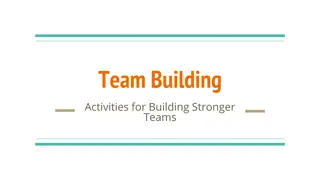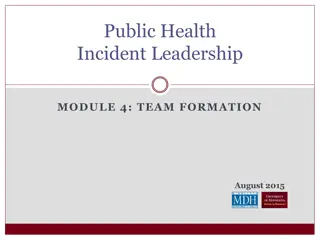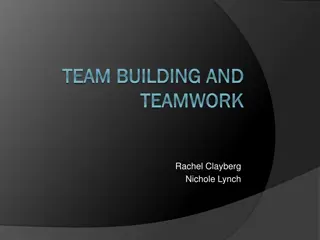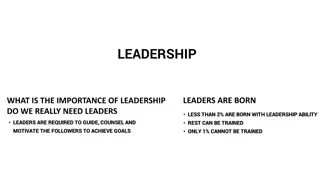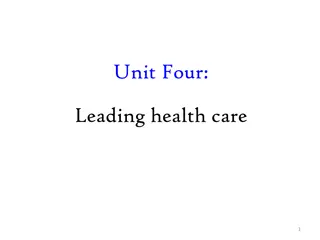Leadership and Team Dynamics Module Overview
Explore the differences between leadership and management in healthcare, understand the value of collaborative working, appreciate team dynamics, and learn how to contribute effectively to various workplace teams. Leadership in nursing highlighted as a critical aspect for improved patient care and outcomes.
Download Presentation

Please find below an Image/Link to download the presentation.
The content on the website is provided AS IS for your information and personal use only. It may not be sold, licensed, or shared on other websites without obtaining consent from the author. Download presentation by click this link. If you encounter any issues during the download, it is possible that the publisher has removed the file from their server.
E N D
Presentation Transcript
Accelerated Preceptorship: Leadership and Team Dynamics Module
Session objectives By the end of the session, you will: understand the difference between leadership and management be aware of situational leadership model understand the value of collaborative working appreciate the lifecycle of a team understand how to contribute effectively to different teams in the workplace. 2
Healthcare isnt delivered by individuals working in isolation, but by complex systems that cross disciplinary and organisational boundaries. Effective clinicians need to understand those systems, be able to work within, and to continually improve those systems for the benefit of society and those we serve. NHS England 3
Reflection Consider the differences between leadership and management in your workplace and identify examples when each is used 4
Leadership vs Management Whilst the terms leadership and management are used interchangeably, there is a difference between the two. Both are required of clinicians in different situations: Management is operational and day-to-day. It involves organising people, resources and time, resolving conflicts, putting together the rota, solving problems and managing a shift, team or service. Leadership is taking the lead in influencing people and focus on the common goal and outcome. Leadership is collaborative, compassionate and inclusive. 5
Leadership in Nursing You should be a model of integrity and leadership for others to aspire to. This should lead to trust and confidence in the professions from patients, people receiving care, other health and care professionals and the public. NMC Code 6
Leadership in Nursing Good leadership in healthcare has been linked to increased patient satisfaction, better patient care and improved patient outcomes. This includes: acting as a role model advocating for a patient taking responsibility and following duty of candour raising concerns taking charge in emergency situations (within scope of practice) managing challenges looking for ways to improve patient experience taking charge on a shift providing guidance / support for students, new starters and others empowering patients to manage their condition challenging poor performance or poor behaviour. 7
Examples of leadership in Nursing Acting as a positive role model new starters, students Advocating for a patient helping them to have their voice heard Taking responsibility and following duty of candour owning up to mistakes Raising concerns completing a datix Taking charge in emergency situations (within scope of practice) crash call Managing challenges finding ways to work with challenging patients Looking for ways to improve patient experience water that is reachable for a patient, offering a hair wash to a bedbound patient Empowering patients to manage their condition ensuring they have appropriate information and encourage them to act on their own Challenging poor performance or poor behaviour colleagues, patients and families 8
Transactional vs Transformational Transactional leadership requires a firm management structure. It is reactive and based on process and control. Transformational leadership is proactive, focuses on vision, change and motivating others to follow. Both have a place in nursing leadership. 9
Leadership styles There are many different models of leadership styles. However, the two which are particularly useful in nursing are: Situational leadership developed by KH Blanchard and J Hersey MBWA developed by Tom Peters and Harry Waterman 10
Situational leadership Developed in 1969, this style looks at the need for different leadership styles in different situations and working with different people. The styles are set on two continuums support vs direction and identifies four different styles: Directive an autocratic style which is low in support and high in direction. Used effectively in emergency situations when one person needs to take control Coaching high in direction and support. This style is used to support and encourage staff and is particularly useful in promoting change and guiding new starters Supporting a more democratic style, whilst high in support it is low in direction and works with staff who are competent but may require additional assistance or confidence Delegating a laissez-faire style which is low in support and direction and is effective with competent, confident people who do not require much management 11
Situational leadership High Directive Directive (S) Coaching (S2) One-way communication Staff roles defined Objectives set by manager Two-way communication Support Guidance and advice High Support Low Support Support from team Structure from within team Shared responsibility Staff consulted Good support Shared decision making Delegating (S4) Supporting (S3) Blanchard and Hersey, 1969 Low Directive 12
Reflection Can you identify the appropriate style for each of these tasks: Crash call Mental health patient absconding from the ward Colleagues not taking lunch breaks or taking too long A patient feeling nervous and scared about an operation A doctor being rude to a staff member Asking a newly qualified to perform a task Asking a porter to collect some bloods A patient refusing to take medication Allocating patients within a shift 13
Appropriate styles Directive - Crash call - Colleagues not taking lunch breaks or taking too long - A doctor being rude to a staff member (to doctor) Coaching - Mental health patient absconding from the ward - Asking a newly qualified to perform a task - Asking a porter to collect some bloods Delegating - Asking a porter to collect some bloods - Allocating patients within a shift Supporting - A patient feeling nervous and scared about an operation - A doctor being rude to a staff member (to staff member 14
Your leadership style We all have different preferences in managing and leading. Some people are very comfortable in giving instructions, whilst others find it difficult. Some people are reluctant to delegate, often due to trust issues, whilst others willingly delegate to staff. Understanding our preferences, helps us to identify areas for development so that we can use all four styles in different situations to become more effective, collaborative leaders. 15
Reflection Thinking about the situational leadership model, can you identify where your strengths are? Which styles do you feel most comfortable with? Which is your least favourite style? How can you develop yourself further in your weaker areas? 16
MBWA Managing by Walking Around First used in 1970s by Hewlett Packard Further developed by Tom Peters and Robert H Waterman (1982) Similar to gemba walk developed by Toyota The idea is that a manager who is working alongside staff develop more effective working relationships, promotes trust and is better able to intervene when there are problems before they become too difficult and to make decisions based on reality. 17
Reflection Consider the benefits of the MBWA style in the workplace. How can this help promote trust with staff? How can this help improve patient outcomes? 18
Reflection What is the impact of poor management or leadership in a clinical workplace? 19
Impact of poor management Low staff morale... increased turnover of staff... staff shortages Lack of qualified, fully trained staff Staff unsure of roles and responsibilities Mistakes, complaints and incidents Poor patient care 20
"Collaborative practice happens when multiple health workers from different professional backgrounds work together with patients, families, carers and communities to deliver the highest quality of care across settings. World Health Organisations, 2010 21
Team dynamics Collaborative practice is key to effective patient care, patient satisfaction and positive outcomes. However, we are all individuals with different skills, experience and attitude. When we bring people together into a team, we create a new entity, one that is unique in its characteristics and dynamics. Working in different teams, both nursing and multi-disciplinary, requires an understanding of team dynamics, an increased self-awareness and a desire to work collaboratively towards the common goals. 22
Characteristics of a team Teams have: a common goal or goals a structure (often hierarchical) and a leader agreed decision making process interdependence with complementary skills to provide a cohesive team-working approach trusting, supportive relationships defined roles (people will often assume informal roles within teams too) clear rules policies, standard operating procedure, ways of working, codes of conduct. 23
Reflection Consider different teams you have worked in. Have there been some teams you have found much easier to work with than others? Why do you think this is? How can you encourage collaborative team working? 24
Benefits of team working Improved patient outcomes and patient satisfaction Greater coordination of tasks Shared workload Increased productivity and more effective use of time Team members feels supported Positive impact on individual health and wellbeing Increased motivation for team members Developing self and other team members through shared learning opportunities Increased creativity in problem solving 25
Reflection What do you consider are the important ingredients of a successful team? 26
Successful teams Respect for each other Common goal of wanting the best for patient Understanding boundaries and different professional roles and responsibilities Understanding of the team process, roles and rules Willingness to work together towards end goal Effective working relationships Trust An open and honest environment Clear, transparent communication Support for each other 27
Reflection Consider ways in which you can promote effective relationships and encourage a collaborative, cohesive approach within teams. 28
Promoting collaborative working Each team member can help to encourage and promote collaborative working by: sharing workload fairly addressing problems and conflict promptly being open, honest and clear in communication sharing information appropriately giving feedback to others (positive and constructive) recognising others strengths and differences asking for help, advice or guidance when needed developing informal team customs remembering small things matter to people. 29
Final reflection What are your preferences: - Managing day to day responsibilities? - Leading a team and having a positive influence? When you ask someone to do a task, do you say: - Can you do this please? - Never mind, I ll do it myself. - Could you do this for me please and I ll help you? Do you prefer to work alone or in a team? What does the team mean to you? At work do you: - prefer to observe others and delegate tasks? - carry out your role and responsibilities? - do your own role and support others? 30
References Drucker, P., The Practice of Management, Harper, New York, 1954; Heinemann, London, 1955; revised edition, Butterworth-Heinemann, 2007 Hersey, P (1985). The Situational Leader. Warner Books, New York World Health Organization. (2010) Framework for action on interprofessional education and collaborative practice: https://www.who.int/publications/i/item/framework-for-action-on- interprofessional-education-collaborative-practice, Geneva, Switzerland: WHO https://www.hee.nhs.uk/our-work/enhancing-generalist-skills/enhance-learning- resources/handbook/cross-cutting-themes/leadership 31
Acknowledgments Written and developed by Desiree Cox, CapitalNurse Preceptorship Project Manager and National Preceptorship Programme Lead, NHS England. With thanks to: Maddy Cox, Clinical Nurse Specialist, Epsom & St Helier Hannah Fosbery, Preceptorship Lead, UCLH Jake Chambers, Preceptorship Lead, Oxleas Riina Hilton, Preceptorship Lead, NELFT 32








